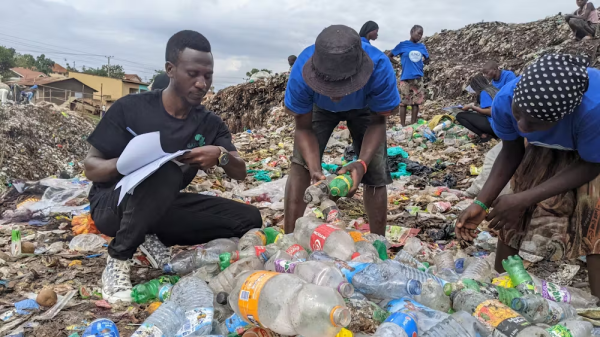- An analysis of public health data in Cambodia has found increased rates of malnutrition among children born in areas where deforestation had recently occurred.
- It also found that pregnant women in these areas were more likely to suffer from anemia, a condition that often correlates with incidences of malaria.
- Cambodia has lost nearly 30% of its forest cover this century, while more than 30% of its children under 5 have stunted growth due to malnutrition.
- The study illustrates how deforestation and the ecological disruptions it causes can compound previously existing rural health issues.

New research has linked prenatal exposure to deforestation in Cambodia to child stunting and anemia among women.
This link between human well-being and forest loss illustrates how the latter can compound preexisting rural health issues in Cambodia, a country notorious for high levels of both deforestation and malnutrition.
Gabriel Fuentes Cordoba, an associate professor at Japan’s Sophia University, combined forest loss data with figures from national demographic health surveys for his recent study on Cambodia. In an email interview with Mongabay, Fuentes Cordoba said his analysis found children born to women in villages within 5 kilometers (3 miles) of “areas that experience deforestation a year before their conception are more likely to be shorter and thinner for their age.”
The results also found women similarly exposed to deforestation the year before conception are more likely to suffer from anemia, a deficiency of healthy red blood cells, which often correlates with incidences of malaria.
Globally, deforestation has been found to exacerbate the risk of malaria. Other recent studies show that the felling of forests, often for agriculture and development, leads to more standing water, creating optimal breeding grounds for malaria parasite-bearing mosquitoes.

Long-lasting consequences
“Health is an important component of human capital,” Fuentes Cordoba said. “For example, there is vast evidence showing that children who are sick perform worse at school. This is just one example of potential long-lasting consequences of how health issues could impact individuals. This could compound at the community level in terms of economic performance.”
The concerns this study attributes to deforestation are long-standing issues in Cambodia. The 2020 Global Nutrition Report found more than 30% of the country’s children under the age of 5 are affected by stunting, a consequence of chronic undernutrition. A 2016 study discovered nearly half of the women of reproductive age in Cambodia suffer from anemia.
Fuentes Cordoba’s findings underline the complex ways that factors like deforestation, water contamination, chronic malnutrition and rural poverty can compound each other.

Health and the forest
Malnutrition and anemia may be well-documented in Cambodia, but deforestation’s impact on human health is a relatively nascent field of study in the country.
In the next few months, UNICEF, in collaboration with the government, will release Cambodia’s first national Children’s Environmental Health Assessment. According to the release, “climate change and environmental degradation are disproportionally threatening children’s survival, health, education, protection, and well-being.”
“Whenever we do a cost-benefit analysis, we should keep in mind the potential negative impact of deforestation on the health conditions of vulnerable individuals exposed to it,” Fuentes Cordoba said.
Deforestation is a tinderbox topic in Cambodia. The government has since the start of the millennium pursued a development goal of becoming a upper middle-income country by 2030. So far, reports have found this dream of development has cost more than 2.6 million hectares (6.4 million acres) — nearly 30% — of Cambodia’s total forest cover.

“There are a lot of perspectives that need to be considered before development begins,” Vuthy Sem, a program coordinator for the advocacy organization EarthRights International, told Mongabay in an interview. “Meaningful conversations need to be had with communities — men, women and children — so they fully understand how deforestation will affect their health and well-being before it begins happening around them.”
In Cambodia’s context, Sem said, laws are in place mandating that these conversations happen. But the reality on the ground.
“Industrial, extractive, market-based development involves deforestation. The two are always inextricably linked,” Courtney Work, an associate professor at Taiwan’s National Chengchi University, told Mongabay in an interview. “When people lose the forest that sustains them, the health impacts are massive.
“Not only that. It’s not just losing the forest, it is gaining the unpaved roads. It’s gaining the massive industrial trucks that are shipping stone and logs out of the forest. It is gaining the migrant populations that come in to grow cash crops using chemical products,” she said.
Work, who has been carrying out research in Cambodia for 19 years, said she could “talk for hours” about all ways she has seen deforestation impact the health of the forest-dwelling communities she’s worked with. She said development is a key driver of the malnutrition issues common across Cambodia, citing the examples of industrial agriculture and smallholder cash crop farming as having transformed productive, nutritious, “clean forests” into barren agricultural landscapes.
“To make clearer the connection between healthy mothers and healthy babies, which of course is the foundation of any healthy community, is really valuable because it does get buried. It gets erased by the discourse of development and progress,” Work said. “The health impacts of what we call developments are astronomical.”
Banner image: People watch a forest fire in Kratié Province, Cambodia. Image by Anton L. Delgado.
Citations:
Fuentes Cordoba, G. (2024). Deforestation and child health in Cambodia. Economics & Human Biology, 52, 101343. doi:10.1016/j.ehb.2023.101343
White, N. J. (2018). Anaemia and malaria. Malaria Journal, 17(1). doi:10.1186/s12936-018-2509-9
Estifanos, T. K., Fisher, B., Galford, G. L., & Ricketts, T. H. (2024). Impacts of deforestation on childhood malaria depend on wealth and vector biology. GeoHealth, 8(3). doi:10.1029/2022gh000764
Wieringa, F. T., Sophonneary, P., Whitney, S., Mao, B., Berger, J., Conkle, J., … Laillou, A. (2016). Low prevalence of iron and vitamin A deficiency among Cambodian women of reproductive age. Nutrients, 8(4), 197. doi:10.3390/nu8040197
Pauly, M., Crosse, W., & Tosteson, J. (2022). High deforestation trajectories in Cambodia slowly transformed through economic land concession restrictions and strategic execution of REDD+ protected areas. Scientific Reports, 12(1). doi:10.1038/s41598-022-19660-0




You must be logged in to post a comment.